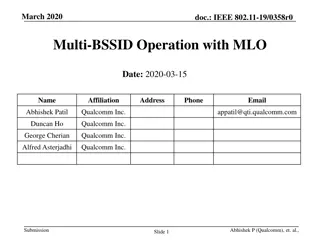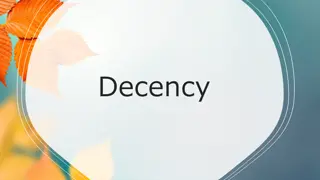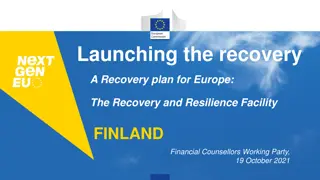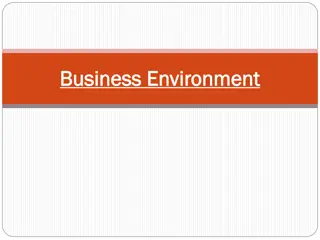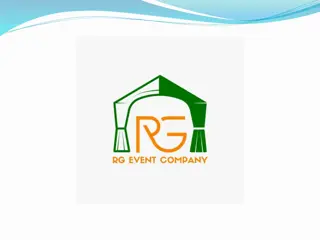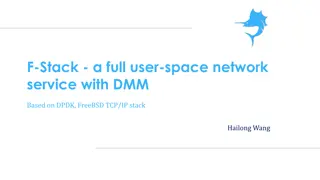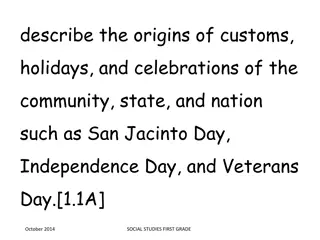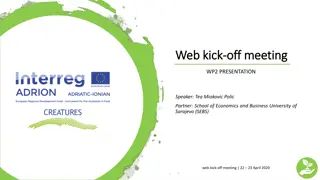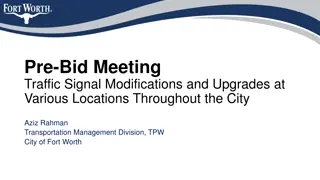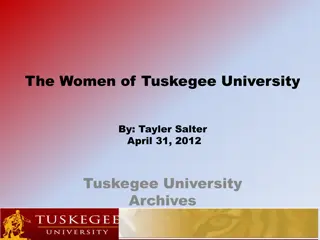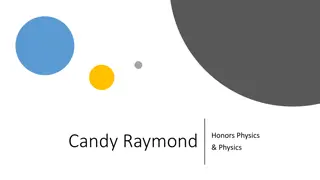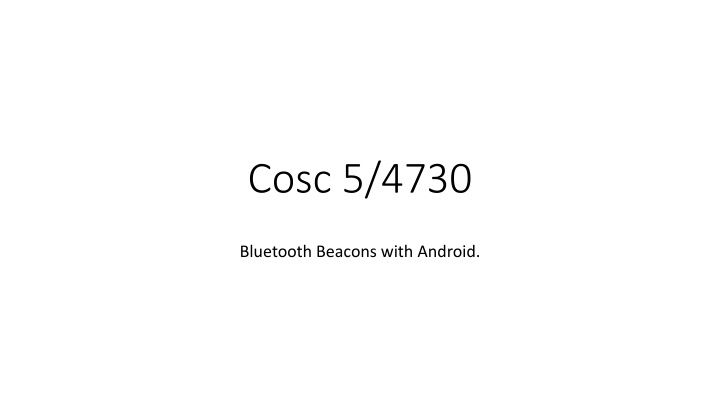
Unlocking the Potential of BLE Beacons and Their Applications
Explore how BLE beacons revolutionize proximity marketing, enhance customer engagement, enable indoor navigation, and more. Learn about setting up and utilizing beacons for various purposes.
Download Presentation

Please find below an Image/Link to download the presentation.
The content on the website is provided AS IS for your information and personal use only. It may not be sold, licensed, or shared on other websites without obtaining consent from the author. If you encounter any issues during the download, it is possible that the publisher has removed the file from their server.
You are allowed to download the files provided on this website for personal or commercial use, subject to the condition that they are used lawfully. All files are the property of their respective owners.
The content on the website is provided AS IS for your information and personal use only. It may not be sold, licensed, or shared on other websites without obtaining consent from the author.
E N D
Presentation Transcript
Cosc 5/4730 Bluetooth Beacons with Android.
What is BLE Beacon Bluetooth Low Energy is a form of wireless communication designed especially for short-range communication. BLE is very similar to Wi-Fi in the sense that it allows devices to communicate with each other. However, BLE is meant for situations where battery life is preferred over high data transfer speeds. For example, say you want to broadcast marketing campaigns in the close proximity of a newly launched headphone.
Beacons https://developers.google.com/nearby/notifications/get-started About $12 to $50 per beacon. You can use beacons instead of a device to broadcast a message. And register them with google so nearby will know the "locations" as well. This allow for more marketing or directions.
What do they look like? Can be just simple USB, that plugs in for power. a battery operated device. The battery may be good for 6 to 12 months before a replacement battery is needed.
Beacons 1. After up get a couple of them. 2. Configure the beacons. 1. Must have a UID (or EID if available)
Beacons (2) Use the Beacon Tools app (by Google) to register it. Note must be registered to a google project (in the dashboard) Give the beacon a name, etc.
We have a beacon or 6, now what? What are beacons good for This is the obvious one: Proximity marketing or sales campaigns.
What are beacons used for? Location Beacons help indicate where you are in a physical space with precision down to a a meter - geofence is much less precise (up to 5 meters) and does not work indoors. Engagement Beacons can trigger various events when used with a smartphone. You enter a room, lights turn on. You enter a shop, coupon is sent to your phone. The event that beacon triggers depends on your business case. Another great example are loyalty programs for customers - beacons help reward customers for purchases or even time spent in a venue. Navigation Beacons are great when it comes to locating people indoors and helping them find a way (locating a person indoors is not possible with traditional geofence technology). What Google Maps does for the outdoors, beacons can do for the indoors. They can tell you where you are and where you re going in a museum, festival, or train station.
What are beacons used for? (2) Analysis & Data Collection With beacon accuracy you can gather more reliable information then from GPS or WiFi signals and learn how and where your customers are moving throughout your shop. Please note that beacons do not collect any data themselves, but with a use of beacons and proximity platforms like Bleesk, you can collect dozens of important metrics about your customers through an app. You can use this data to improve your product listings and in-store layout, refine your customer journey, tailor future marketing campaigns and boost your in- store conversions. Asset & People Tracking One of the beacons more practical use cases is something many of us would never have guessed. In manufacturing and transport, managers need to know exactly where goods are at any given time. By attaching beacons, they can always have that information. Interaction Whether it s making sure patients don t go in the wrong wing or alerting factory workers to dangerous changes, beacons can automatically send notifications (either to app users or property owners) about a safety issue. Beacons can also be paired with geofencing to add an extra layer to data security.
Real world example application. Find mine X. (note this Tile and apple company is basically doing) Let's say find Jim's coffee cup, because I keep leaving in places. First get a beacon and attach it to my coffee cup (maybe one of the stickers). We need to install an app on the phone. Using an identifying number of the beacon, it keeps track of if its in range. Options 1. When the beacon goes out of range, put an alert on the phone. 2. While the beacon is in range, note the location. The user can then ask for it's location. 1. Note, many beacons can also give you a range estimate between the phone and beacon. Another option as well. The beacon could also be logged into the companies servers. If you lose the beacon, not just your app, but ever instance of the app installed could also look for the beacon. If any person's phone sees the beacon, they could report it to the servers and you.
Real world example application (2) Conference centers, hotels, other large venues could use indoor navigation. Each beacon is placed and it's location is noted. With enough beacons, your phone will know where you are based on one or more beacons (with your distance from them) and then give you directions or a map to where you want to go. With google closing down their beacon registration, this will no longer be available in indoor google app's as the company had once announced. With something like a museum, zoo, etc You would install the app, besides navigation, you can get information. You could even have a full guided tour from your phone with both audio and video about the exhibits.
Real world example application (3) Covid Contact tracking uses beacons broadcast by the phones. http://www.davidgyoungtech.com/2020/04/24/hacking-with- contact-tracing-beacons
Android Beacon Library We can use the GATT and all those pieces to try and do all the work. Or we can use some libraries. Android Beacon Library (sponsored by Radius networks) https://altbeacon.github.io/android-beacon-library/index.html provides interfaces and methods to interact with beacons. Supports most beacon types (default is AltBeacons). Ibeacon and Eddystone-EID/URL/TLM
Adding In studio, in your dependency section (like androidx libraries) implementation 'org.altbeacon:android-beacon-library:2+' currently 2.17.1 //needed for the beacon library, hopefully in 2.17.2+ they fix the error. implementation 'androidx.localbroadcastmanager:localbroadcastmanager:1.0.0' Permissions <uses-permission android:name="android.permission.INTERNET" /> <uses-permission android:name="android.permission.ACCESS_BACKGROUND_LOCATION" /> <uses-permission android:name="android.permission.ACCESS_FINE_LOCATION" /> <uses-permission android:name="android.permission.FOREGROUND_SERVICE" /> You only need background_location if you plan to have your app running in background and find beacons in API 29+ <uses-permission android:name="android.permission.BLUETOOTH_SCAN" /> <uses-permission android:name="android.permission.BLUETOOTH_CONNECT"/> add these for api 31+
How it works. There are two pieces to the library. a MonitorNotifier (you can multiple different notifiers setup as well) This will tell you are detecting 1 or more beacons that you are looking for. Or you can set it, to tell when you have found any beacons, which my example does. RangeNotifier (again, you should be to setup separate notifiers if you want) Again, you setup to detect 1 or more beacons or all beacons. This gives you a list of all the beacons it's found and information about each beacon. You can also setup your app to broadcast a beacon as well. be careful about battery use.
basic setup get an instance BeaconManager beaconManager = BeaconManager.getInstanceForApplication(this); add more parsers, default is just altbeacons Detect the main identifier (UID) frame: beaconManager.getBeaconParsers().add(new BeaconParser().setBeaconLayout(BeaconParser.EDDYSTONE_UID_LAYOUT));
MonitorNotifier part (v18 and below) setup the notifier callback. And start monitoring for beacons. beaconManager.addMonitorNotifier(new MonitorNotifier() { try { @Override beaconManager.startMonitoringBeaconsInRegion(new Region("myMonitoringUniqueId", null, null, null)); public void didEnterRegion(Region region) { logthis("beacon monitor listener has been added."); logthis("I'm seeing at one beacon."); } catch (RemoteException e) { @Override logthis("FAILED beacon monitor listener has been added." + e.toString()); public void didExitRegion(Region region) { logthis("I no longer any beacons."); } It's nulls you change to detect a set or even one beacon you are looking for. } @Override Identifier myBeaconNamespaceId = Identifier.parse("0x2f234454f4911ba9ffa6"); public void didDetermineStateForRegion(int state, Region region) { Identifier myBeaconInstanceId = Identifier.parse("0x000000000001"); //state == MonitorNotifier.INSIDE then in a region, or MonitorNotifier.OUTSIDE, then no beacons. Region region = new Region("my-beacon-region", myBeaconNamespaceId, myBeaconInstanceId, null); } });
v19+ uses viewmodel and observers. setup a "region", this is for everything Region myRegion = new Region("myMonitoringUniqueId", null, null, null); now start the monitor beaconManager.getRegionViewModel(myRegion).getRegionState().observe(this, new Observer<Integer>() { @Override public void onChanged(Integer state) { if (state == MonitorNotifier.INSIDE) Log.d(TAG, "Detected beacons(s)"); else Log.d(TAG, "Stopped detecting beacons"); } }); beaconManager.startMonitoring(myRegion); //starts it.
RangeNotifier v18 and below //beacon info, this case just show me all of them. Region region = new Region("all-beacons-region", null, null, null); try { beaconManager.startRangingBeaconsInRegion(region); } catch (RemoteException e) { e.printStackTrace(); } And the notifier pieces. beaconManager.addRangeNotifier(new RangeNotifier() { @Override public void didRangeBeaconsInRegion(Collection<Beacon> beacons, Region region) { logthis("didRangeBeaconsInRegion called with beacon count: " + beacons.size()); //next slide for more on Beacons. } });
viewModel ranged beacons for v19+ beaconManager.getRegionViewModel(myRegion).getRangedBeacons(). observe(this, new Observer<Collection<Beacon>>() { @Override public void onChanged(Collection<Beacon> beacons) { Log.d(TAG, "didRangeBeaconsInRegion called with beacon count: " + beacons.size()); for (Beacon beacon : beacons) { //do something with the beacons. see next slide. } }); beaconManager.startRangingBeacons(myRegion); //start it up.
Beacons. What's in the beacons changes depending on the type, but we have these standard information. getDistance will give you an estimate of it range getManufacturer() and getBeaconTypeCode(), getters for Bluetooth info. getId1(), getId2(), getId3() are convenice methods for the identifiers varies depending on the type, altbecon, eddystone, etc. Eddystone-UID id1 is namespaceId, and id2 is instanceId Eddystone-URL id1 is bytes array of the URL UrlBeaconUrlCompressor.uncompress(beacon.getId1().toByteArray());
Demo in the Bluetooth repo androidlibrarydemo is a simple demo with a textview logger androidlibrarydemo2 separates the monitor and range so you can see the different information easier. beacons are listed in a recyclerview for rangemonitor.
references https://altbeacon.github.io/android-beacon-library/index.html https://altbeacon.github.io/android-beacon-library/samples.html https://altbeacon.github.io/android-beacon- library/javadoc/reference/packages.html https://github.com/AltBeacon https://github.com/AltBeacon/android-beacon-library-reference
QA &





